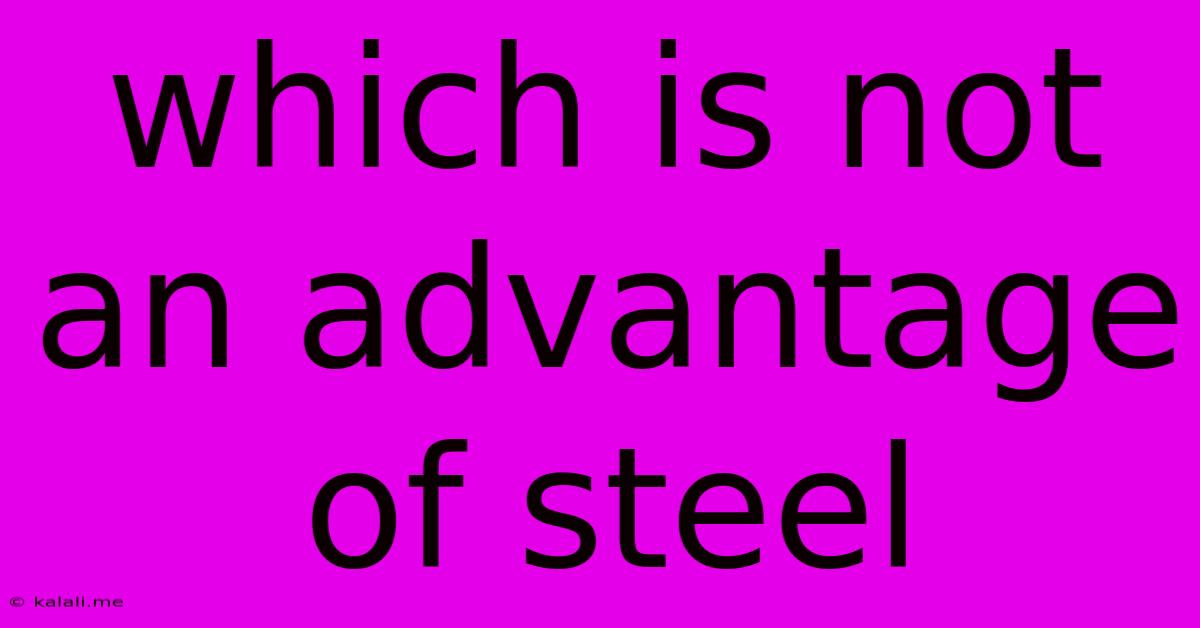Which Is Not An Advantage Of Steel
Kalali
Jun 13, 2025 · 3 min read

Table of Contents
Which is NOT an Advantage of Steel? Uncovering the Drawbacks of a Construction Giant
Steel. The backbone of modern construction, a symbol of strength and durability. But even this industrial titan isn't without its flaws. While boasting numerous advantages, including high tensile strength, versatility, and recyclability, understanding its limitations is crucial for informed decision-making in various applications. This article delves into the aspects where steel falls short, exploring the downsides that often outweigh its benefits in specific contexts.
What are the common advantages of steel? Before we delve into the disadvantages, let's briefly refresh our understanding of why steel is so popular. Its high strength-to-weight ratio, excellent ductility (ability to be deformed without breaking), and weldability make it ideal for a wide range of applications. Furthermore, steel is readily recyclable, making it an environmentally friendly option compared to some other materials. Its resistance to compression is another frequently touted advantage.
So, what are the disadvantages? Now, let's get to the core of this article: identifying the scenarios where steel is not the best choice.
1. Susceptibility to Corrosion: A Major Drawback
One of the most significant disadvantages of steel is its vulnerability to corrosion. Exposure to moisture, oxygen, and certain chemicals can lead to rust, significantly weakening the structural integrity of steel components. This necessitates the application of protective coatings like paint or galvanization, adding to the overall cost and complexity of projects. This is especially a concern in marine environments or areas with high humidity. Materials like stainless steel offer improved corrosion resistance but often come with a higher price tag.
2. High Initial Cost: A Budgetary Consideration
While steel's longevity can be advantageous in the long run, the initial cost of steel materials and fabrication can be substantial, particularly when compared to alternative materials such as wood or certain types of concrete. This initial investment can be a barrier for smaller projects or those with tighter budgets.
3. Weight and Transportation Challenges: Logistics and Handling
Steel's high density translates to considerable weight, making transportation and handling a logistical challenge. Larger steel structures necessitate specialized equipment and expertise for safe and efficient movement, increasing project costs and complexity. This aspect is particularly critical in remote locations or areas with limited infrastructure.
4. Potential for Fatigue Failure: Long-Term Considerations
Over time, repeated stress and strain can lead to fatigue failure in steel structures. This is a critical factor to consider in applications experiencing cyclical loading, such as bridges or aircraft components. Regular inspections and maintenance are essential to mitigate the risk of fatigue-related failures.
5. Thermal Expansion and Contraction: Temperature Sensitivity
Steel is susceptible to thermal expansion and contraction, meaning it expands when heated and contracts when cooled. In applications with significant temperature fluctuations, this can lead to stress and potential cracking, especially in structures with fixed components. This is a key consideration in areas with extreme temperature variations.
6. Lack of Flexibility in Certain Designs: Design Limitations
While steel offers versatility, its inherent properties may limit its suitability for certain designs demanding high flexibility or intricate shapes. Other materials might offer more advantageous properties in such situations.
In conclusion, while steel remains a dominant material in many construction and manufacturing applications, it's crucial to weigh its advantages against its potential drawbacks. Understanding the limitations of steel—its susceptibility to corrosion, high initial cost, weight, fatigue, thermal sensitivity, and design constraints—is vital for making informed decisions that optimize project success and longevity. The "best" material always depends on the specific project requirements and context.
Latest Posts
Latest Posts
-
Which Of The Following Is A Correct Pair
Jun 14, 2025
-
A Substance Through Which A Wave Can Travel Is A
Jun 14, 2025
-
What Is 9 Percent In Decimal Form
Jun 14, 2025
-
In Analyzing A Series Rlc Circuit The Reference Is The
Jun 14, 2025
-
What Is The Prime Factorization For 225
Jun 14, 2025
Related Post
Thank you for visiting our website which covers about Which Is Not An Advantage Of Steel . We hope the information provided has been useful to you. Feel free to contact us if you have any questions or need further assistance. See you next time and don't miss to bookmark.